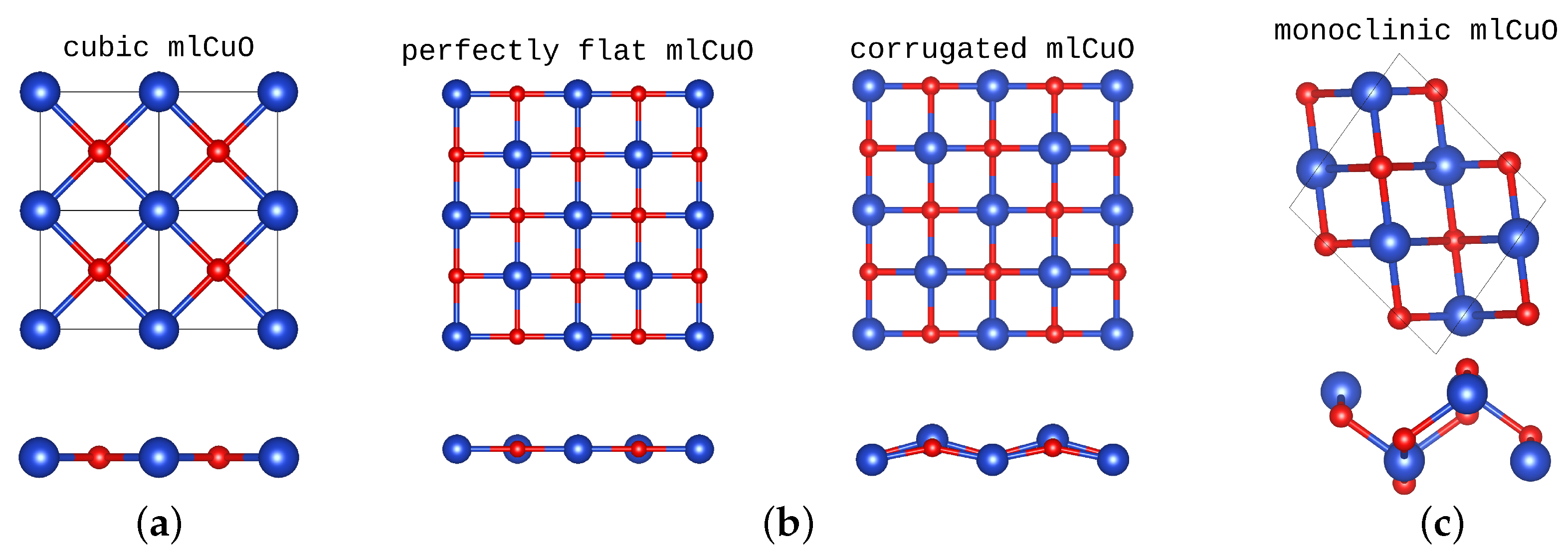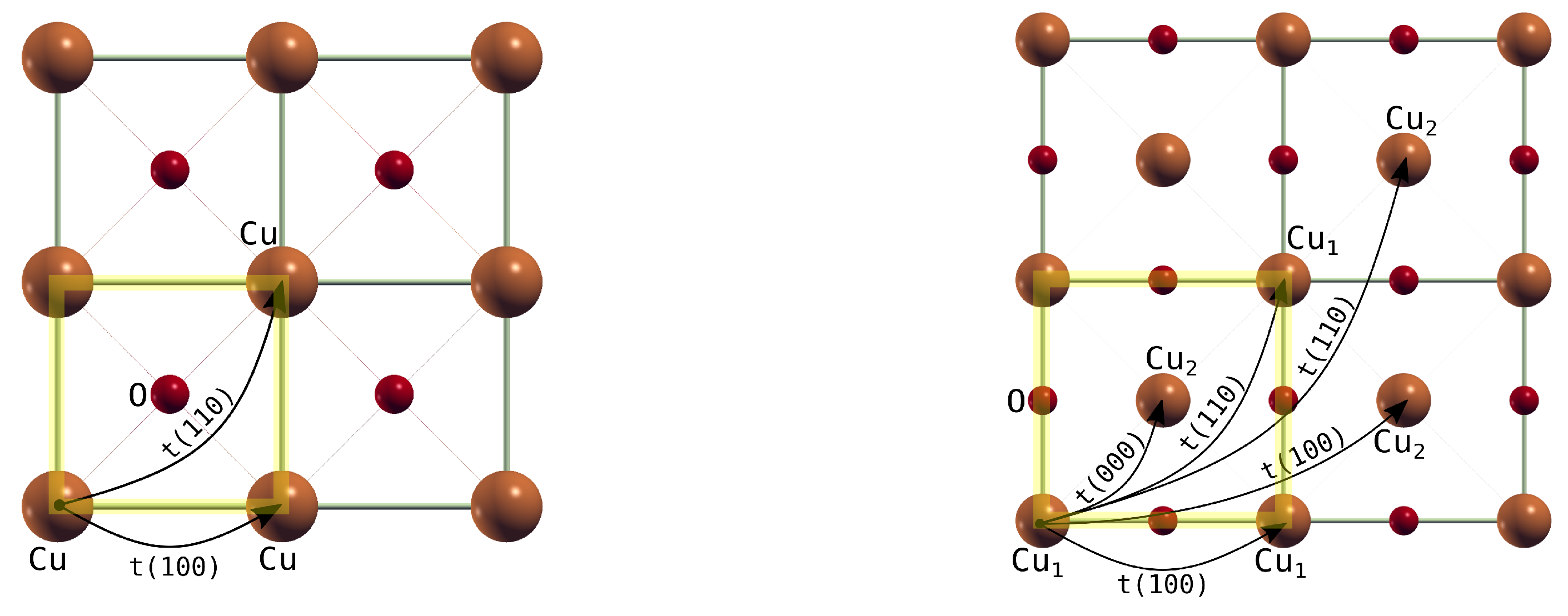Electronic Structure and Minimal Models for Flat and Corrugated CuO Monolayers: An Ab Initio Study
Abstract
1. Introduction
2. Crystal Structure and Calculation Details
3. Results and Discussion
3.1. Electronic Structure
3.2. Minimal Models
4. Conclusions
Supplementary Materials
Author Contributions
Funding
Acknowledgments
Conflicts of Interest
Appendix A
| - | - | |||||
|---|---|---|---|---|---|---|
| 126 | 169 | |||||
| 226 | ||||||
| 0 | 0 | |||||
| - | ||||||
|---|---|---|---|---|---|---|
| Doubled u.c. | Corrugated | |||||
| 124 | 73 | 161 | 86 | |||
| 13 | 5 | |||||
| - | ||||||
|---|---|---|---|---|---|---|
| Doubled u.c. | Corrugated | |||||
| 167 | 82 | 24 | 85 | |||
| 10 | ||||||
| 0 | 0 | 0 | 0 | 30 | ||
| 0 | 0 | 0 | 41 | 31 | 31 | |
| 0 | 0 | 0 | 41 | 7 | ||
| 0 | 0 | 0 | 34 | |||
| 18 | 41 | 5 | 0 | 14 | 14 | |
| 53 | 43 | |||||
| 18 | 5 | 4 | 4 | |||
| 0 | 0 | 47 | 0 | 0 | 28 | |
| 2 | ||||||
| 246 | 206 | |||||
References
- Anisimov, V.I.; Zaanen, J.; Andersen, O.K. Band theory and Mott insulators: Hubbard U instead of Stoner I. Phys. Rev. B 1991, 44, 943–954. [Google Scholar] [CrossRef] [PubMed]
- Ruiz, E.; Alvarez, S.; Alemany, P.; Evarestov, R.A. Electronic structure and properties of Cu2O. Phys. Rev. B 1997, 56, 7189–7196. [Google Scholar] [CrossRef]
- Ghijsen, J.; Tjeng, L.H.; van Elp, J.; Eskes, H.; Westerink, J.; Sawatzky, G.A.; Czyzyk, M.T. Electronic structure of Cu2O and CuO. Phys. Rev. B 1998, 38, 11322–11330. [Google Scholar] [CrossRef] [PubMed]
- Heinemann, M.; Eifert, B.; Heiliger, C. Band structure and phase stability of the copper oxides Cu2O, CuO, and Cu4O3. Phys. Rev. B 2013, 87, 115111. [Google Scholar] [CrossRef]
- Pickett, W.E. Electronic structure of the high-temperature oxide superconductors. Rev. Mod. Phys. 1989, 61, 433–512. [Google Scholar] [CrossRef]
- Reitz, J.B.; Solomon, E.I. Propylene Oxidation on Copper Oxide Surfaces: Electronic and Geometric Contributions to Reactivity and Selectivity. J. Am. Chem. Soc. 1998, 120, 11467–11478. [Google Scholar] [CrossRef]
- Nakaoka, K.; Ueyama, J.; Ogura, K. Photoelectrochemical Behavior of Electrodeposited CuO and Cu2O Thin Films on Conducting Substrates. J. Electrochem. Soc. 2004, 151, C661. [Google Scholar] [CrossRef]
- Kim, S.Y.; Ahn, C.H.; Lee, J.H.; Kwon, Y.H.; Hwang, S.; Lee, J.Y.; Cho, H.K. p-Channel Oxide Thin Film Transistors Using Solution-Processed Copper Oxide. ACS Appl. Mater. Interfaces 2013, 5, 2417–2421. [Google Scholar] [CrossRef]
- Åsbrink, S.; Norrby, L.J. A refinement of the crystal structure of copper(II) oxide with a discussion of some exceptional e.s.d.’s. Acta Crystallogr. Sect. B 1970, 26, 8–15. [Google Scholar] [CrossRef]
- Schmahl, N.G.; Eikerling, G.F. Über Kryptomodifikationen des Cu(II)-Oxids. Z. Für Phys. Chem. 1968, 62, 268–279. [Google Scholar] [CrossRef]
- Ekuma, C.; Anisimov, V.; Moreno, J.; Jarrell, M. Electronic structure and spectra of CuO. Eur. Phys. J. B 2014, 87, 23. [Google Scholar] [CrossRef]
- Wu, D.; Zhang, Q.; Tao, M. LSDA+U study of cupric oxide: Electronic structure and native point defects. Phys. Rev. B 2006, 73, 235206. [Google Scholar] [CrossRef]
- Nolan, M.; Elliott, S.D. The p-type conduction mechanism in Cu2O: A first principles study. Phys. Chem. Chem. Phys. 2006, 8, 5350–5358. [Google Scholar] [CrossRef] [PubMed]
- Cao, H.; Zhou, Z.; Yu, J.; Zhou, X. DFT study on structural, electronic, and optical properties of cubic and monoclinic CuO. J. Comput. Electron. 2018, 17, 21–28. [Google Scholar] [CrossRef]
- Grant, P.M. Electronic properties of rocksalt copper monoxide: A proxy structure for high temperature superconductivity. J. Phys. Conf. Ser. 2008, 129, 012042. [Google Scholar] [CrossRef]
- Cipriano, L.A.; Di Liberto, G.; Tosoni, S.; Pacchioni, G. Band Gap in Magnetic Insulators from a Charge Transition Level Approach. J. Chem. Theory Comput. 2020, 16, 3786–3798. [Google Scholar] [CrossRef] [PubMed]
- Yazdani, A.; Barakati, B. A first-principles study on electronic structure and crystal field effect of layered La2CuO4 as composed of CuO2 and La2O2 monolayers. Phys. E Low-Dimens. Syst. Nanostructures 2021, 125, 114395. [Google Scholar] [CrossRef]
- Yin, K.; Zhang, Y.Y.; Zhou, Y.; Sun, L.; Chisholm, M.F.; Pantelides, S.T.; Zhou, W. Unsupported single-atom-thick copper oxide monolayers. 2D Mater. 2016, 4, 011001. [Google Scholar] [CrossRef]
- Kano, E.; Kvashnin, D.G.; Sakai, S.; Chernozatonskii, L.A.; Sorokin, P.B.; Hashimoto, A.; Takeguchi, M. One-atom-thick 2D copper oxide clusters on graphene. Nanoscale 2017, 9, 3980–3985. [Google Scholar] [CrossRef]
- Kvashnin, D.G.; Kvashnin, A.G.; Kano, E.; Hashimoto, A.; Takeguchi, M.; Naramoto, H.; Sakai, S.; Sorokin, P.B. Two-Dimensional CuO Inside the Supportive Bilayer Graphene Matrix. J. Phys. Chem. C 2019, 123, 17459–17465. [Google Scholar] [CrossRef]
- Blaha, P.; Schwarz, K.; Tran, F.; Laskowski, R.; Madsen, G.K.H.; Marks, L.D. WIEN2k: An APW+lo program for calculating the properties of solids. J. Chem. Phys. 2020, 152, 074101. [Google Scholar] [CrossRef] [PubMed]
- Perdew, J.P.; Burke, K.; Ernzerhof, M. Generalized Gradient Approximation Made Simple. Phys. Rev. Lett. 1996, 77, 3865–3868. [Google Scholar] [CrossRef] [PubMed]
- Monkhorst, H.J.; Pack, J.D. Special points for Brillouin-zone integrations. Phys. Rev. B 1976, 13, 5188. [Google Scholar] [CrossRef]
- Pizzi, G.; Vitale, V.; Arita, R.; Blügel, S.; Freimuth, F.; Géranton, G.; Gibertini, M.; Gresch, D.; Johnson, C.; Koretsune, T.; et al. Wannier90 as a community code: New features and applications. J. Phys. Condens. Matter. 2020, 32, 165902. [Google Scholar] [CrossRef] [PubMed]







Disclaimer/Publisher’s Note: The statements, opinions and data contained in all publications are solely those of the individual author(s) and contributor(s) and not of MDPI and/or the editor(s). MDPI and/or the editor(s) disclaim responsibility for any injury to people or property resulting from any ideas, methods, instructions or products referred to in the content. |
© 2023 by the authors. Licensee MDPI, Basel, Switzerland. This article is an open access article distributed under the terms and conditions of the Creative Commons Attribution (CC BY) license (https://creativecommons.org/licenses/by/4.0/).
Share and Cite
Slobodchikov, A.A.; Nekrasov, I.A.; Begunovich, L.V.; Makarov, I.A.; Korshunov, M.M.; Ovchinnikov, S.G. Electronic Structure and Minimal Models for Flat and Corrugated CuO Monolayers: An Ab Initio Study. Materials 2023, 16, 658. https://doi.org/10.3390/ma16020658
Slobodchikov AA, Nekrasov IA, Begunovich LV, Makarov IA, Korshunov MM, Ovchinnikov SG. Electronic Structure and Minimal Models for Flat and Corrugated CuO Monolayers: An Ab Initio Study. Materials. 2023; 16(2):658. https://doi.org/10.3390/ma16020658
Chicago/Turabian StyleSlobodchikov, Anatoly A., Igor A. Nekrasov, Lyudmila V. Begunovich, Ilya A. Makarov, Maxim M. Korshunov, and Sergey G. Ovchinnikov. 2023. "Electronic Structure and Minimal Models for Flat and Corrugated CuO Monolayers: An Ab Initio Study" Materials 16, no. 2: 658. https://doi.org/10.3390/ma16020658
APA StyleSlobodchikov, A. A., Nekrasov, I. A., Begunovich, L. V., Makarov, I. A., Korshunov, M. M., & Ovchinnikov, S. G. (2023). Electronic Structure and Minimal Models for Flat and Corrugated CuO Monolayers: An Ab Initio Study. Materials, 16(2), 658. https://doi.org/10.3390/ma16020658







